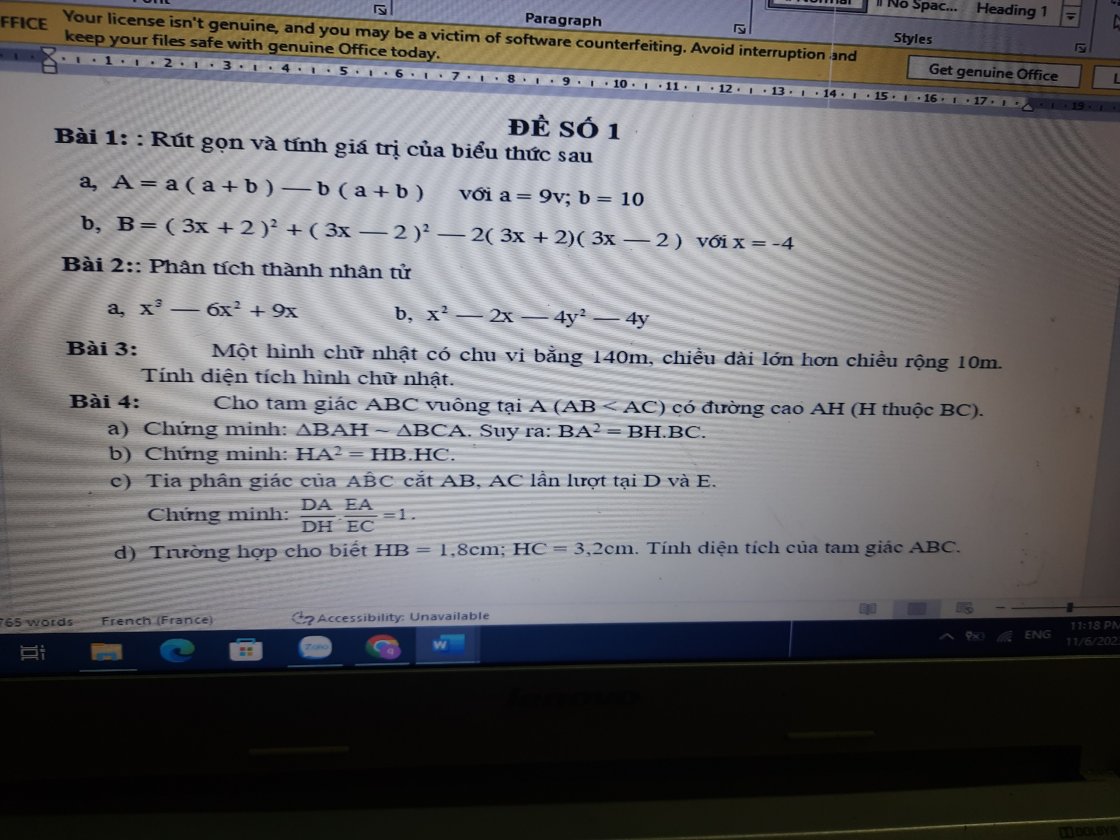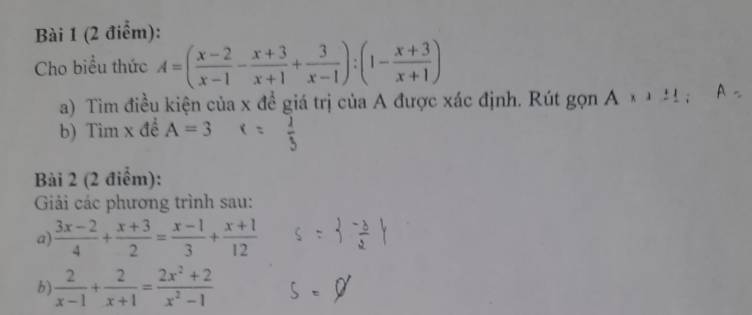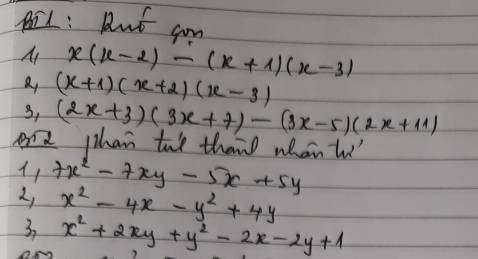
Hãy nhập câu hỏi của bạn vào đây, nếu là tài khoản VIP, bạn sẽ được ưu tiên trả lời.


3:
1: =>15x-9x+6=45-10x+25
=>6x+6=-10x+70
=>16x=64
=>x=4
2: =>x^2+4x-16-16=0
=>x^2+4x-32=0
=>(x+8)(x-4)=0
=>x=4 hoặc x=-8
3: ĐKXĐ: x<>4; x<>-4
\(PT\Leftrightarrow\dfrac{x+4+\left(x+2\right)\left(x-4\right)}{\left(x-4\right)\left(x+4\right)}=\dfrac{5x-4}{\left(x-4\right)\left(x+4\right)}\)
=>x+4+x^2-2x-8=5x-4
=>x^2-x-4=5x-4
=>x^2-6x=0
=>x(x-6)=0
=>x=0 hoặc x=6
4: \(\Leftrightarrow5\left(4x+1\right)-x+2>=3\left(2x-3\right)\)
=>20x+5-x+2>=6x-9
=>19x+7>=6x-9
=>13x>=-16
=>x>=-16/13

\(D=\dfrac{x^2}{x^2-1}+\dfrac{1}{x^2-x^4}=\dfrac{x^4}{x^2\left(x^2-1\right)}-\dfrac{1}{x^2\left(x^2-1\right)}=\dfrac{x^4-1}{x^2\left(x^2-1\right)}=\dfrac{\left(x^2-1\right)\left(x^2+1\right)}{x^2\left(x^2-1\right)}=\dfrac{x^2+1}{x^2}=1+\dfrac{1}{x^2}\)
do \(x\ne0,\pm1\Rightarrow\dfrac{1}{x^2}>0\Rightarrow1+\dfrac{1}{x^2}>1\Rightarrow D>1\left(đpcm\right)\)
\(D=\dfrac{x^2}{x^2-1}+\dfrac{1}{x^2-x^4}\\ =\dfrac{x^4\left(1-x\right)}{\left(x-1\right)\left(x+1\right)\left(1-x\right)x^2}+\dfrac{x-1}{x^2\left(1-x\right)\left(1+x\right)\left(x-1\right)}\\ =\dfrac{x^4-x^5+x-1}{x^2\left(1-x\right)\left(1+x\right)\left(x-1\right)}\\ =\dfrac{-\left(x-1\right)^2\left(x^2+1\right)\left(x+1\right)}{-x^2\left(x-1\right)^2\left(x+1\right)}\\ =\dfrac{x^2+1}{x^2}>1\left(đpcm\right)\)
(x2 + 1 luôn lớn hơn x2)

Bài 1. (a) Điều kiện: \(x\ne\pm1\).
Ta có: \(A=\left(\dfrac{x-2}{x-1}-\dfrac{x+3}{x+1}+\dfrac{3}{x-1}\right):\left(1-\dfrac{x+3}{x+1}\right)\)
\(=\left(\dfrac{x-2+3}{x-1}-\dfrac{x+3}{x+1}\right):\dfrac{x+1-\left(x+3\right)}{x+1}\)
\(=\left(\dfrac{x+1}{x-1}-\dfrac{x+3}{x+1}\right):\dfrac{x+1-x-3}{x+1}\)
\(=\dfrac{\left(x+1\right)^2-\left(x+3\right)\left(x-1\right)}{\left(x-1\right)\left(x+1\right)}:\dfrac{-2}{x+1}\)
\(=\dfrac{x^2+2x+1-x^2-2x+3}{\left(x-1\right)\left(x+1\right)}\cdot\dfrac{x+1}{-2}\)
\(=\dfrac{4}{\left(x-1\right)\left(x+1\right)}\cdot\dfrac{x+1}{-2}=\dfrac{2}{1-x}\)
Vậy: \(A=\dfrac{2}{1-x}\)
(b) \(A=3\Leftrightarrow\dfrac{2}{1-x}=3\)
\(\Rightarrow1-x=\dfrac{2}{3}\Leftrightarrow x=\dfrac{1}{3}\left(TM\right)\)
Vậy: \(x=\dfrac{1}{3}\)
Bài 2. (a) Phương trình tương đương với:
\(\dfrac{3\left(3x-2\right)}{12}+\dfrac{6\left(x+3\right)}{12}=\dfrac{4\left(x-1\right)}{12}+\dfrac{x+1}{12}\)
\(\Rightarrow3\left(3x-2\right)+6\left(x+3\right)=4\left(x-1\right)+x+1\)
\(\Leftrightarrow9x-6+6x+18=4x-4+x+1\)
\(\Leftrightarrow10x=-15\Leftrightarrow x=-\dfrac{3}{2}\)
Vậy: Phương trình có tập nghiệm \(S=\left\{-\dfrac{3}{2}\right\}\).
(b) Điều kiện: \(x\ne\pm1\). Phương trình tương đương với:
\(\dfrac{2\left(x+1\right)}{\left(x-1\right)\left(x+1\right)}+\dfrac{2\left(x-1\right)}{\left(x+1\right)\left(x-1\right)}=\dfrac{2x^2+2}{\left(x+1\right)\left(x-1\right)}\)
\(\Rightarrow2\left(x+1\right)+2\left(x-1\right)=2x^2+2\)
\(\Leftrightarrow2x+2+2x-2=2x^2+2\)
\(\Leftrightarrow2x^2-4x+2=0\Leftrightarrow2\left(x^2-2x+1\right)=0\)
\(\Leftrightarrow2\left(x-1\right)^2=0\Rightarrow x-1=0\Leftrightarrow x=1\left(KTM\right)\)
Vậy: Phương trình có tập nghiệm \(S=\varnothing\)

2:
1: =7x(x-y)-5(x-y)
=(x-y)(7x-5)
2: =(x^2-y^2)-(4x-4y)
=(x-y)(x+y)-4(x-y)
=(x-y)(x+y-4)
3: =(x^2+2xy+y^2)-(2x+2y)+1
=(x+y)^2-2(x+y)+1
=(x+y-1)^2

1) ( a + b ) ( a + b )
= a2 + ab + ab + b2
= a2 + 2ab + b2
2) ( a+ b ) ( a - b )
= a2 - ab + ab -b2
= a2 - b2
3) ( a - b ) ( a + b )
= a2 + ab - ab - b2
= a2 - b2
Hk tốt

bài 1
gọi thời gian đi từ A đến B là x(h;x>0)
nên vận tốc là 20x(km)
do thời gian lúc về nhiêu hơn lúc đi là 10'=\(\dfrac{1}{6}\) h
nên thời gian là x+\(\dfrac{1}{6}\left(h\right)\)
nên quãng đường là \(15\left(x+\dfrac{1}{6}\right)\) (km)
vì trên cùng 1 quãng đường nên ta có pt
\(20x=15\left(x+\dfrac{1}{6}\right)\)
⇔\(20x=15x+\dfrac{5}{2}\)
⇔20x-15x=\(\dfrac{5}{2}\)
⇔\(5x=\dfrac{5}{2}\)
⇔x=0,5(h)
Quãng đường AB là 20x=20.0,5=10(km)
vậy quãng đường AB là 10km
-Gọi t1 là thời gian của người đi xe đạp đi từ A đến B
-Gọi t2 là thời gian của người đi xe đạp đi từ B đến A
-do thời gian về hơn thời gian đi là 10 phút = \(\dfrac{1}{6}\)h
=> t2= t1 + \(\dfrac{1}{6}\)
-ta có: S1= v1 . t1 = 20t1
S2= v2 . t2 = 15.( t1 + \(\dfrac{1}{6}\))
-mà S1 = S2
=>20t1 = 15 ( t1 + \(\dfrac{1}{6}\))
<=>20t1=15t1 + 2,5
<=>20t1 - 15t1= 2,5
<=> 5t1 = 2,5
<=>t1=0,5
=> S1 = v1.t1=20 . 0,5=10
Vậy quãng đường AB dài 10km

 mn giup mik bai 3 nay dc ko aj
mn giup mik bai 3 nay dc ko aj


chữ xú ko dịch nổi...
bài 1 và 3 thôi ạ